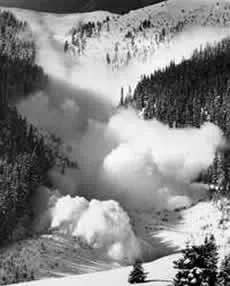Cryosphere glossary
atmospheric circulation
the large-scale movement of air, and the means by which heat is distributed on the surface of the Earth; may vary from year to year.
atmospheric phenomenon
as commonly used in weather observing practice, an observable occurrence of particular physical significance within the atmosphere; from the viewpoint of weather observations, the atmospheric phenomena include all hydrometeors (precipitation types and fogs), blowing snow, thunderstorms, tornadoes, waterspouts, and others.
atmospheric pressure
pressure (force per unit area) exerted by the atmosphere on any surface by virtue of its weight; it is equivalent to the weight of a vertical column of air extending above a surface of unit area to the outer limit of the atmosphere.
atmospheric radiation
longwave (infrared) radiation emitted by or being propagated through the atmosphere.
aurora
luminous phenomena, in the form of arcs, bands, draperies, or curtains in the high atmosphere over high latitudes; auroras are related to magnetic storms and the influx of charged particles from the sun, the phenomena are called aurora borealis in the northern hemisphere and aurora australis in the southern hemisphere.
avalanche
mass of snow which becomes detached and slides down a slope, often acquiring great bulk by fresh addition as it descends.
Image

An avalanche in motion.
Richard Armstrong, National Snow and Ice Data Center
average value
arithmetic mean (m) of a number (n) of values (x1, x2, ... xn), defined by the equation: m = sxi/n; annual average value is calculated from 12 monthly means; daily average (or mean) value is calculated from 24 hourly readings of a meteorological element, or often from the average of the daily maximum and minimum values (for example, of temperature); monthly average is usually calculated as the average of the daily average values.
Azores high
the semipermanent subtropical high over the North Atlantic Ocean, especially when it is located over the eastern part of the ocean; the same high over the western part of the Atlantic is called the Bermuda high; on mean charts of sea level pressure, this high is one of the primary centers of action in northern latitudes.
band ogives
alternate bands of light and dark on a glacier; usually found below steep narrow icefalls and thought to be the result of different flow and ablation rates between summer and winter.
banded cryogenic fabric
a distinct soil micromorphology, resulting from the effects of freezing and thawing processes, in which soil particles form subhorizontal layers.
barograph
a barometer that records barometric pressure over time (days or weeks).
barometer
an instrument for measuring atmospheric pressure; two types of barometers are commonly used in meteorology: the mercury barometer and the aneroid barometer.
barrens
areas of discontinuous vegetation cover in the polar semi-desert of the high arctic.
basal cryopeg
a layer of unfrozen ground that is perennially cryotic (t < 0 degrees Celsius), forming the basal portion of the permafrost.
basal cryostructure
the cryostructure of a frozen deposit of boulders that is saturated with ice.
basal sliding
the sliding of a glacier over bedrock.
basal-layered cryostructure
the cryostructure of a frozen layered deposit of gravel and boulders that is saturated with ice.
beaded stream
a stream characterized by narrow reaches linking pools or small lakes.
Beaufort Gyre
an ocean and ice circulation pattern in the Beaufort Sea, north of Alaska. This gyre moves in a clockwise direction, fed by an average high-pressure system that fosters anti-cyclonic winds. Ice that forms in or drifts into the Beaufort Gyre has historically remained in the Arctic ice system for years, accumulating snow and thickening each winter. Beginning in the late 1990s, the ice began melting away while in the southern parts of the gyre, before completing the circulation.
bedrock
hard-packed rock lying below the Earths surface; lies in beds or layers; can be variable across geographic space; above bedrock is a layer of broken, weathered rock.